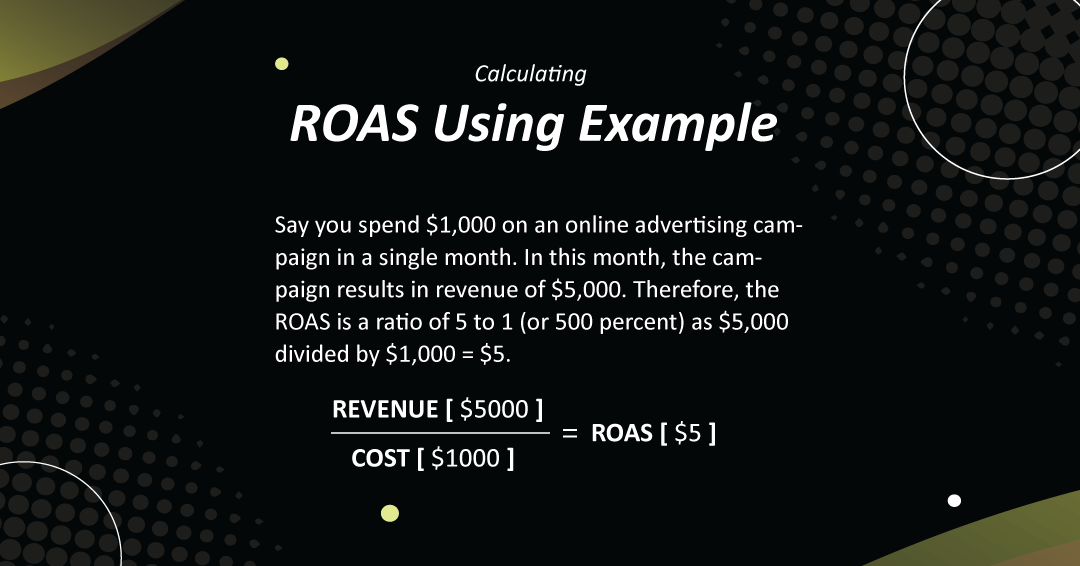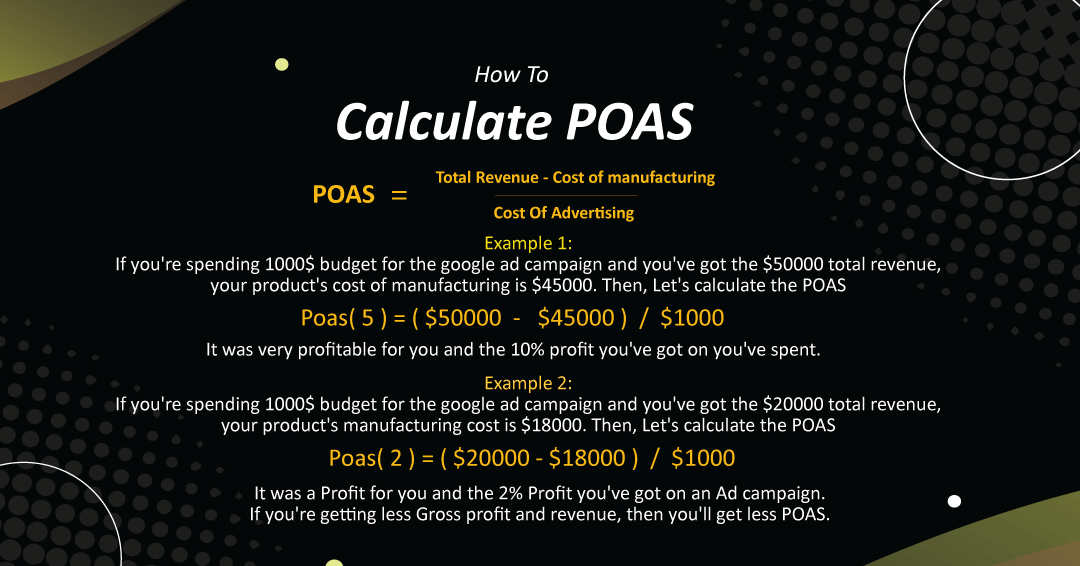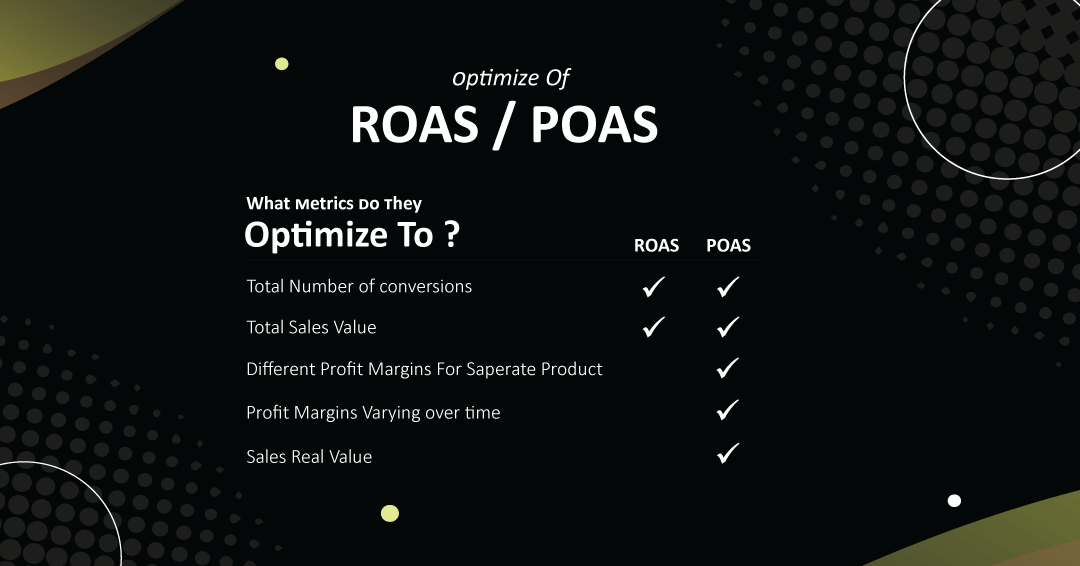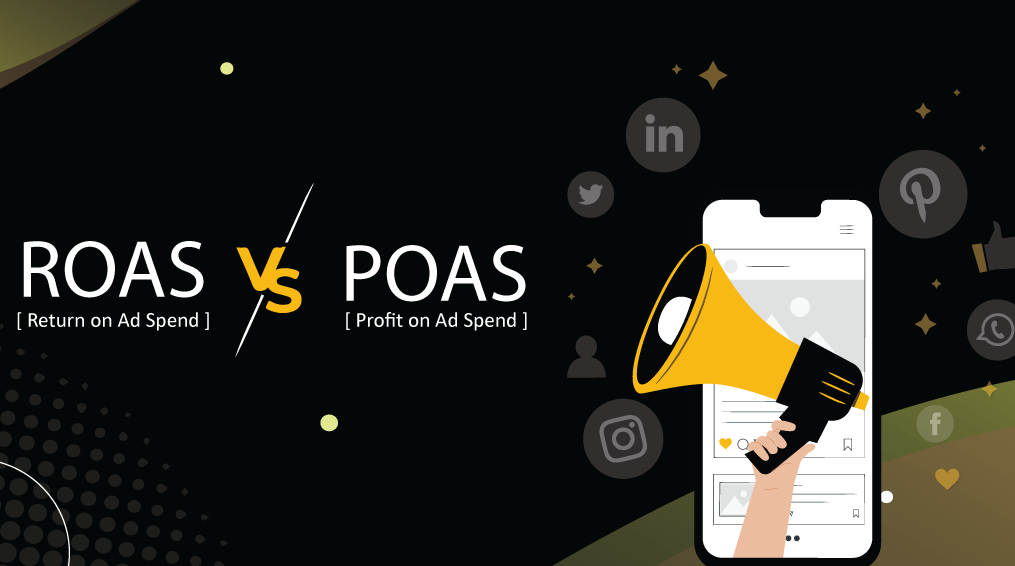Return On Ad Spend VS Profit On Ad Spend
ROAS is a word that Google advertisers are aware of; it stands for Exchange On Ad Spend, or what you gain in return for what you expend on advertising. Also, the POAS purpose (Profit On Ad Spend) is now in play. The POAS is also the profit, or sufficiently yet, the gross margin per ad separated by the cost of advertising. Some claim that it supplies a particularly more authentic view of your campaign’s profitability.
In the ever-evolving world of digital marketing, all it brings is a split second for people to change from one platform or method to another. And those who do not follow the present become a thing of the past & this is why advertisers require a base for analysis that can enable them to complete better.
The emphasis of online marketers is gradually transforming from ROAS to POAS. Today, some marketers believe POAS to be a more precise arrow of your PPC campaign’s profitability and conversion rates than ROAS. Online advertising is rapidly changing, and some marketers now believe POAS marketing to be a more precise indicator of the profitability and conversion rates of your PPC campaign than ROAS.
ROAS, and it’s working.

Return on Ad Spend (ROAS) is a revenue-based marketing metric for online eCommerce advertisers that estimates the significance of a digital advertising campaign. ROAS aids an internet business in deciding which methods are influential and how to optimize future advertising exertions.
Target ROAS permits you to bid based on the expected return on ad spend (ROAS). This innovative bidding system permits you to improve conversion value or income while preserving your target return on ad spend. Your requests are automatically optimized at auction time, permitting you to customize bids for individual auctions. Available as a single-campaign basic technique or as a portfolio technique for many campaigns.
How To Calculate ROAS
Say you spend $1,000 on an online advertising campaign in a single month. In this month, the campaign results in revenue of $5,000. Therefore, the ROAS is a ratio of 5 to 1 (or 500 percent) as $5,000 divided by $1,000 = $5.
ROAS ($5) = REVENUE($5000)/COST($1000)

POAS, and it’s working.

Sounded, the gross profit attributable to the eCommerce internet marketing channel when ad spending is considered. The focus on POAS assures that you will make more profitable decisions that will enhance the profitability of your campaigns. You bypass breaking the sinful efforts or investing in campaigns that emerge profitable at first glance but are not.
You can effortlessly decide if POAS is the answer for you. For each advertisement, can you smoothly calculate the amount earned? Can you calculate the margin based on the conversion value at the individual level if the margin is identical for the per product?
How To Calculate POAS

POAS= (Total Revenue – Cost of manufacturing) / Cost Of Advertising
Example 1:
If you’re spending 1000$ budget for the google ad campaign and you’ve got the $50000 total revenue, your product’s cost of manufacturing is $45000. Then, Let’s calculate the POAS
Poas(5) = ($50000- $45000)/$1000
It was very profitable for you and the 10% profit you’ve got on you’ve spent.
Example 2
If you’re spending 1000$ budget for the google ad campaign and you’ve got the $20000 total revenue, your product’s manufacturing cost is $18000. Then, Let’s calculate the POAS
Poas(2) = ($20000- $18000)/$1000
It was a Profit for you and the 2% Profit you’ve got on an Ad campaign.
If you’re getting less Gross profit and revenue, then you’ll get less POAS.
ROAS goals and target ROAS
But first, back to the ROAS. The ROAS reveals what a distinctive eCommerce ad group/campaign or keyword has delivered in terms of the conversion value. There is an essential difference between a ROAS goal and a target ROAS.

You can specify a ROAS goal at all kinds of levels. Sometimes 1 plan is followed by an exclusive account. Another alternative is to set a ROAS target per product category or brand. This way, you can have considerable ROAS objectives within a single company.
Target ROAS is another story: that’s Google’s bidding technique.
For instance, if you set the target ROAS to 500%, Google strives to develop at least 5 euros in payment for every euro spent on clicks. If you sell shoes with a turnover value of 200 euros – and that sale arrives through Google Ads – then Google may not spend more than 40 euros on clicks.
POAS target: why is ROAS shifting to POAS
Let’s define POAS. Why is ROAS redirecting to a POAS target? Well, let us demonstrate. POAS may be a unique term, but the approach already existed. Some organizations have been running based on a POAS objective for years. However, most associations still glance at a ROAS objective because it is more manageable to set up. By placing a special pixel on the site, the turnover can be regained moderately easily from the order confirmation page. Profit value will not be shown here because this is competition-sensitive information.

In expansion, each organization estimates the gain significance differently, and confident essential choices are made as to which costs are not incorporated. It is also necessary to mention that most marketers want to maximize sales and are entirely not decided based on a profit target.
Why then the shift? The shift from ROAS to POAS is primarily because the optimization options within campaigns are increasingly disappearing.
To achieve a competitive advantage in campaign types such as Smart Shopping, it is increasingly about who can transmit the best data signals to Google. Is your opponent bringing profitability into account, and you’re not? Then there is a reasonable chance you will yield the conversions with the highest profit value. You are then left with the conversion for which you obtain small value in return or even defeats.

So, how to use POAS target?
You can control a sinful image of your outcomes by reaching not the turnover but the margin per advertisement against the costs, so notice the profitability per advertisement. That is the POAS: the Profit On Ad Spend. The POAS is also the profit (better still: gross margin) per ad separated by the advertising costs.
Deploy POAS target yourself in three steps
Depending on your product range, there are additional techniques to apply POAS. Here We demonstrate which three steps you have to accept and which alternatives you can assemble within these steps:
Step 1: define your gross margins.
It would be best to make a difference between your internal costs and your costs for Google Ads.
We also direct to gross profit data that you send to Google. The costs for eCommerce Google Ads have also been removed from the net profit. Because you create this difference, you eventually have an even more useful picture of your profitability.
You can calculate your margins in 2 ways:
1) Calculate your gross margins yourself
Determine the cost items per order and calculate the margin on your orders,
for instance, with Excel.
2) Link data together in a software tool
By merging data from your systems in,
for instance, PPC management software, you can specify the margin on order more smoothly and quickly.
Step 2: Allocate your gross margins to your Ads to acquire insight into your net margins

Then select one of the modes below for connecting your profit margins:
1) Google Click ID (GCLID)
Make a conversion action in eCommerce Google Ads to which you occasionally send a list of transformations. You specify your conversions yourself and can also contain the value (the gross margin in this case).
Provide a GCLID so that Google can allocate the conversion to the click associated with an individual ad. So you can calculate the POAS over the advertisement.
2) Set a goal in Analytics
A goal set up in analytics is a trigger that goes off under specific occurrences,
for instance, playing a video, clicking through a link, reaching a certain page, etc.
So you can connect a value to that trigger, and in the case of POAS, you link the gross margin to it. This way, your margins can be assigned to advertisements. You can then import the margins from Analytics into Google Ads.
Step 3: Send on the accurate data and improve your net margin
Once you have your gross margins in eCommerce Google Ads, you can utilize Google’s bidding techniques to improve your net margin. Make sure that only the conversion extent with the margins is contained in conversions in the campaigns with the bid approach.
You can then set a ROAS objective, or instead: a POAS objective. You set this in the identical place where you normally set your ROAS. Our suggestion is not to ask for too much margin (e.g., 300% or 400%) from Google, but to perforate to a POAS of 120% to 150%.
Note: The bidding procedure will incur quite a lot of money in the commencement because it still has to learn. You can modify the allocation here if it is essential to decrease costs somewhat.
Conclusion
POAS should be top of the reason for eCommerce brands, however, whether you perform in a different market or sell an extensive range of low-cost products at scale.
It delivers more reasonable reporting at both the granular and topline level. It permits you to optimize towards and maximize returns. It’s a model we’re making out for the prevalence of our clients as long as it suits their business goals.
In certain, POAS serves brands with tiny margins and extensive product amounts; driving towards profit from an extensive range is your main objective. We set up automatic trackers that show cost and profit per product, authorizing us to maximize profits and drive spending at a more coarse level.
Secondary to that, it’s helpful if you have a lot of conflict in your profit margins. If you have one range that’s affordable to create but positively desired at a product level, you want it to maintain more weight than one that depends on smaller profit.
Furthermore, Born Techies is the eCommerce enabler and official partner of Adobe Bronze Solution Partner, BigCommerce Preferred Partner & Shopware Business Partner.
Born Techies –Digital Commerce agency offers Shopify, Shopware, Magento, and Bigcommerce development with the latest technologies.
At Born Techies, we focus on Performance, Technology, and Control. We utilize an excellent mix of talent and tech. If you’re curious about speaking to us about how we can go granular clearness and significant dimensions for your business, get in touch with the team here.

